University Case Study: Holistic Care of Violet Paterson (NUR250)
VerifiedAdded on 2023/01/17
|12
|3574
|31
Case Study
AI Summary
This case study focuses on Violet Paterson, a 77-year-old woman admitted with an acute myocardial infarction (AMI), detailing the application of the clinical reasoning cycle in her care. It encompasses a thorough consideration of her medical history, including hypertension and osteoarthritis, and explores the pathophysiology of AMI. The nursing assessments include ECG, cardiac CT, blood tests, pain assessments, and fall risk assessments. The care plan prioritizes managing decreased cardiac output, hypertension, and pain, with interventions such as medication, physiotherapy, and environmental modifications. Patient education emphasizes lifestyle modifications. The case study also includes a review of evaluation methods to determine the effectiveness of interventions and promote better health outcomes. The assignment aims to demonstrate the student's ability to apply the clinical reasoning cycle to develop and plan comprehensive nursing care for a patient with a complex medical history.

Running head: CASE STUDY OF VIOLET
CASE STUDY OF VIOLET
Name of the student:
Name of the university:
Author note:
CASE STUDY OF VIOLET
Name of the student:
Name of the university:
Author note:
Paraphrase This Document
Need a fresh take? Get an instant paraphrase of this document with our AI Paraphraser
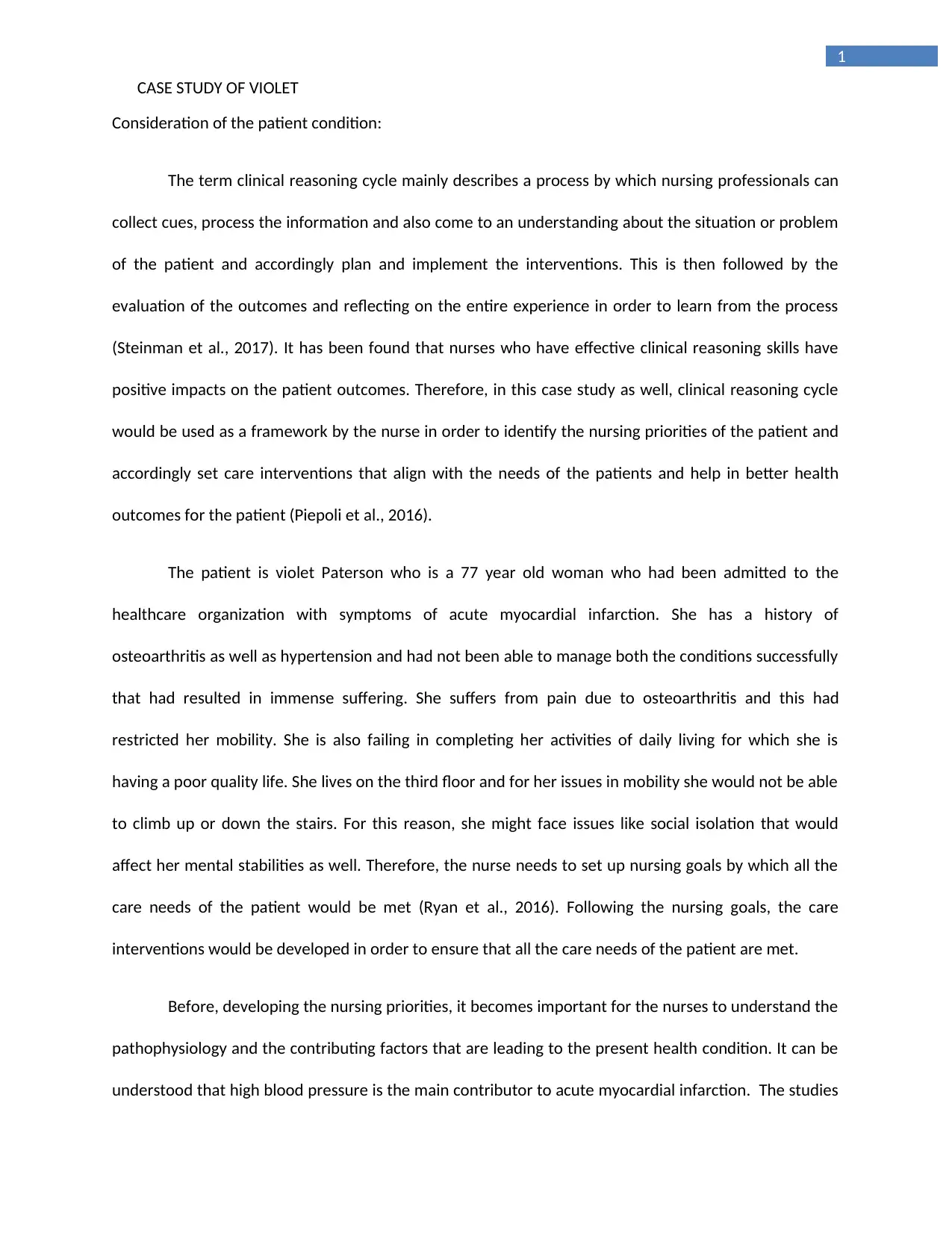
1
CASE STUDY OF VIOLET
Consideration of the patient condition:
The term clinical reasoning cycle mainly describes a process by which nursing professionals can
collect cues, process the information and also come to an understanding about the situation or problem
of the patient and accordingly plan and implement the interventions. This is then followed by the
evaluation of the outcomes and reflecting on the entire experience in order to learn from the process
(Steinman et al., 2017). It has been found that nurses who have effective clinical reasoning skills have
positive impacts on the patient outcomes. Therefore, in this case study as well, clinical reasoning cycle
would be used as a framework by the nurse in order to identify the nursing priorities of the patient and
accordingly set care interventions that align with the needs of the patients and help in better health
outcomes for the patient (Piepoli et al., 2016).
The patient is violet Paterson who is a 77 year old woman who had been admitted to the
healthcare organization with symptoms of acute myocardial infarction. She has a history of
osteoarthritis as well as hypertension and had not been able to manage both the conditions successfully
that had resulted in immense suffering. She suffers from pain due to osteoarthritis and this had
restricted her mobility. She is also failing in completing her activities of daily living for which she is
having a poor quality life. She lives on the third floor and for her issues in mobility she would not be able
to climb up or down the stairs. For this reason, she might face issues like social isolation that would
affect her mental stabilities as well. Therefore, the nurse needs to set up nursing goals by which all the
care needs of the patient would be met (Ryan et al., 2016). Following the nursing goals, the care
interventions would be developed in order to ensure that all the care needs of the patient are met.
Before, developing the nursing priorities, it becomes important for the nurses to understand the
pathophysiology and the contributing factors that are leading to the present health condition. It can be
understood that high blood pressure is the main contributor to acute myocardial infarction. The studies
CASE STUDY OF VIOLET
Consideration of the patient condition:
The term clinical reasoning cycle mainly describes a process by which nursing professionals can
collect cues, process the information and also come to an understanding about the situation or problem
of the patient and accordingly plan and implement the interventions. This is then followed by the
evaluation of the outcomes and reflecting on the entire experience in order to learn from the process
(Steinman et al., 2017). It has been found that nurses who have effective clinical reasoning skills have
positive impacts on the patient outcomes. Therefore, in this case study as well, clinical reasoning cycle
would be used as a framework by the nurse in order to identify the nursing priorities of the patient and
accordingly set care interventions that align with the needs of the patients and help in better health
outcomes for the patient (Piepoli et al., 2016).
The patient is violet Paterson who is a 77 year old woman who had been admitted to the
healthcare organization with symptoms of acute myocardial infarction. She has a history of
osteoarthritis as well as hypertension and had not been able to manage both the conditions successfully
that had resulted in immense suffering. She suffers from pain due to osteoarthritis and this had
restricted her mobility. She is also failing in completing her activities of daily living for which she is
having a poor quality life. She lives on the third floor and for her issues in mobility she would not be able
to climb up or down the stairs. For this reason, she might face issues like social isolation that would
affect her mental stabilities as well. Therefore, the nurse needs to set up nursing goals by which all the
care needs of the patient would be met (Ryan et al., 2016). Following the nursing goals, the care
interventions would be developed in order to ensure that all the care needs of the patient are met.
Before, developing the nursing priorities, it becomes important for the nurses to understand the
pathophysiology and the contributing factors that are leading to the present health condition. It can be
understood that high blood pressure is the main contributor to acute myocardial infarction. The studies
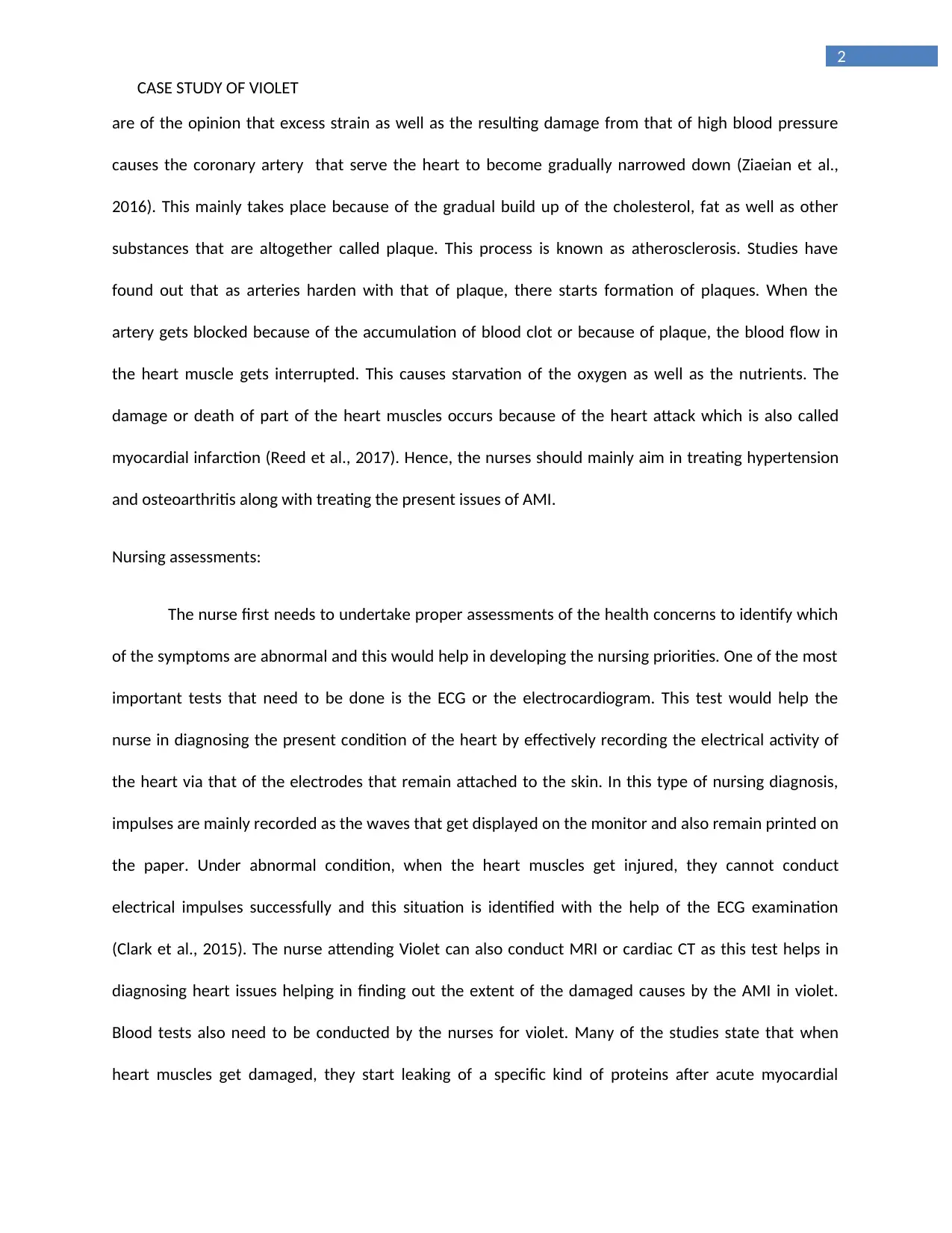
2
CASE STUDY OF VIOLET
are of the opinion that excess strain as well as the resulting damage from that of high blood pressure
causes the coronary artery that serve the heart to become gradually narrowed down (Ziaeian et al.,
2016). This mainly takes place because of the gradual build up of the cholesterol, fat as well as other
substances that are altogether called plaque. This process is known as atherosclerosis. Studies have
found out that as arteries harden with that of plaque, there starts formation of plaques. When the
artery gets blocked because of the accumulation of blood clot or because of plaque, the blood flow in
the heart muscle gets interrupted. This causes starvation of the oxygen as well as the nutrients. The
damage or death of part of the heart muscles occurs because of the heart attack which is also called
myocardial infarction (Reed et al., 2017). Hence, the nurses should mainly aim in treating hypertension
and osteoarthritis along with treating the present issues of AMI.
Nursing assessments:
The nurse first needs to undertake proper assessments of the health concerns to identify which
of the symptoms are abnormal and this would help in developing the nursing priorities. One of the most
important tests that need to be done is the ECG or the electrocardiogram. This test would help the
nurse in diagnosing the present condition of the heart by effectively recording the electrical activity of
the heart via that of the electrodes that remain attached to the skin. In this type of nursing diagnosis,
impulses are mainly recorded as the waves that get displayed on the monitor and also remain printed on
the paper. Under abnormal condition, when the heart muscles get injured, they cannot conduct
electrical impulses successfully and this situation is identified with the help of the ECG examination
(Clark et al., 2015). The nurse attending Violet can also conduct MRI or cardiac CT as this test helps in
diagnosing heart issues helping in finding out the extent of the damaged causes by the AMI in violet.
Blood tests also need to be conducted by the nurses for violet. Many of the studies state that when
heart muscles get damaged, they start leaking of a specific kind of proteins after acute myocardial
CASE STUDY OF VIOLET
are of the opinion that excess strain as well as the resulting damage from that of high blood pressure
causes the coronary artery that serve the heart to become gradually narrowed down (Ziaeian et al.,
2016). This mainly takes place because of the gradual build up of the cholesterol, fat as well as other
substances that are altogether called plaque. This process is known as atherosclerosis. Studies have
found out that as arteries harden with that of plaque, there starts formation of plaques. When the
artery gets blocked because of the accumulation of blood clot or because of plaque, the blood flow in
the heart muscle gets interrupted. This causes starvation of the oxygen as well as the nutrients. The
damage or death of part of the heart muscles occurs because of the heart attack which is also called
myocardial infarction (Reed et al., 2017). Hence, the nurses should mainly aim in treating hypertension
and osteoarthritis along with treating the present issues of AMI.
Nursing assessments:
The nurse first needs to undertake proper assessments of the health concerns to identify which
of the symptoms are abnormal and this would help in developing the nursing priorities. One of the most
important tests that need to be done is the ECG or the electrocardiogram. This test would help the
nurse in diagnosing the present condition of the heart by effectively recording the electrical activity of
the heart via that of the electrodes that remain attached to the skin. In this type of nursing diagnosis,
impulses are mainly recorded as the waves that get displayed on the monitor and also remain printed on
the paper. Under abnormal condition, when the heart muscles get injured, they cannot conduct
electrical impulses successfully and this situation is identified with the help of the ECG examination
(Clark et al., 2015). The nurse attending Violet can also conduct MRI or cardiac CT as this test helps in
diagnosing heart issues helping in finding out the extent of the damaged causes by the AMI in violet.
Blood tests also need to be conducted by the nurses for violet. Many of the studies state that when
heart muscles get damaged, they start leaking of a specific kind of proteins after acute myocardial
⊘ This is a preview!⊘
Do you want full access?
Subscribe today to unlock all pages.

Trusted by 1+ million students worldwide

3
CASE STUDY OF VIOLET
infarction. When these proteins are present in the blood, the nurses can easily understand that the
heart damage had taken place and accordingly interventions would be set.
Nurses also need to understand the present situation of the patient regarding her osteoarthritis
issues. Nurses should first need to assess the pain conditions of Violet and the nurses can do so by
taking the help of pain measurement tool. This pain measurements scale mainly includes the value from
0 to 10 with zero signifying lowest level of pain and ten signifying the highest level of pain (Allen et al.,
2016). Another important assessment that should also be done for violet is the fall risk assessment. As
Violet stays is her apartment and suffers from extreme pain due to osteoarthritis, she might face
mobility issues thereby increasing of her chances of fall. . Hence, the fall risk assessment tool famously
called the FRAT should be used to identify the fall risks of Violet. This tool has three important
components which are Part 1 - falls risk status; Part 2 – risk factor checklist; and Part 3 – action plan. This
would mainly be helping the nurses in taking precautionary measures that would help in prevention
from falls.
Nurses should also need to undertake the assessments of blood pressure of the patient to
develop an understanding of his conditions of hypertension. The blood pressure measurement is an
important component of the vital signs. The nurses need to undertake 3 blood pressure readings at a
time interval of about 2 minutes with the help of the mercury nanometer (Finny et al., 2016). This would
help the nurse to gather knowledge about the blood pressure level of violet and accordingly help them
to finalize the nursing goals.
Care planning:
One of the nursing goals for the patient would be to develop the decreased cardiac output. The
patient named violet might be exposed to the risk for inadequate blood that are pumped by the heart
which may affect the metabolic needs of the body. Therefore, taking the interventions for managing her
CASE STUDY OF VIOLET
infarction. When these proteins are present in the blood, the nurses can easily understand that the
heart damage had taken place and accordingly interventions would be set.
Nurses also need to understand the present situation of the patient regarding her osteoarthritis
issues. Nurses should first need to assess the pain conditions of Violet and the nurses can do so by
taking the help of pain measurement tool. This pain measurements scale mainly includes the value from
0 to 10 with zero signifying lowest level of pain and ten signifying the highest level of pain (Allen et al.,
2016). Another important assessment that should also be done for violet is the fall risk assessment. As
Violet stays is her apartment and suffers from extreme pain due to osteoarthritis, she might face
mobility issues thereby increasing of her chances of fall. . Hence, the fall risk assessment tool famously
called the FRAT should be used to identify the fall risks of Violet. This tool has three important
components which are Part 1 - falls risk status; Part 2 – risk factor checklist; and Part 3 – action plan. This
would mainly be helping the nurses in taking precautionary measures that would help in prevention
from falls.
Nurses should also need to undertake the assessments of blood pressure of the patient to
develop an understanding of his conditions of hypertension. The blood pressure measurement is an
important component of the vital signs. The nurses need to undertake 3 blood pressure readings at a
time interval of about 2 minutes with the help of the mercury nanometer (Finny et al., 2016). This would
help the nurse to gather knowledge about the blood pressure level of violet and accordingly help them
to finalize the nursing goals.
Care planning:
One of the nursing goals for the patient would be to develop the decreased cardiac output. The
patient named violet might be exposed to the risk for inadequate blood that are pumped by the heart
which may affect the metabolic needs of the body. Therefore, taking the interventions for managing her
Paraphrase This Document
Need a fresh take? Get an instant paraphrase of this document with our AI Paraphraser

4
CASE STUDY OF VIOLET
risk of decreased cardiac output would be the first goal. The interventions need to be planned then. The
nursing professionals should first try to monitor the heart rate as well as the rhythm and documents any
form of dysrhythmias via telemetry. The main rationale behind this is that heart rate as well as heart
rhythm can respond to different types of medications as well as activities and development of other
conditions (Harris et al., 2015). Dysrhythmia can also compromise the cardiac function and can thereby
increase the ischemic damages. Moreover, acute as well a chronic flutter might be seen with that of
coronary artery or valvular involvement and this might or might not be pathological. The nurse should
also note down the responses to the various types of activities and accordingly they should promote rest
in the patient successfully. The main rationale is that overexertion might cause increase in the oxygen
consumption and oxygen demands which may in turn compromise the myocardial infarction. Violet
should be also given easily digestible and small meals along with limited caffeine containing products.
Large meals should not be provided as this would increase the myocardial workload and can also result
in vegal stimulation which might in turn increase the chances of ectopic heart beats and chances of
bradycardia (Porcheret et al., 2018). Caffeine is a direct cardiac stimulator and can also increase her
heart rate. Then effective evaluation needs to be done. With the help of the thoracic electrical
bioimpedance (TEB) technique, cardiac index, cardiac preload, cardiac after-load, contractility and
cardiac work should be measured. This would help in understanding the cardiac output and the different
functional parameters. This would help to understand whether the therapeutic interventions are
bringing out positive results or not.
The second nursing goal for the patient is management of the hypertension issue. Hypertension
is mainly acting as one of the risk factors for the acute myocardial infarction that had occurred in the
patient. Hence, managing this health condition is considered to be important. The interventions need to
be first comprising of medication therapy that would help in reducing the blood pressure level of Violet.
The nurse can provide the medications like that of the calcium channel blockers that help in lowering
CASE STUDY OF VIOLET
risk of decreased cardiac output would be the first goal. The interventions need to be planned then. The
nursing professionals should first try to monitor the heart rate as well as the rhythm and documents any
form of dysrhythmias via telemetry. The main rationale behind this is that heart rate as well as heart
rhythm can respond to different types of medications as well as activities and development of other
conditions (Harris et al., 2015). Dysrhythmia can also compromise the cardiac function and can thereby
increase the ischemic damages. Moreover, acute as well a chronic flutter might be seen with that of
coronary artery or valvular involvement and this might or might not be pathological. The nurse should
also note down the responses to the various types of activities and accordingly they should promote rest
in the patient successfully. The main rationale is that overexertion might cause increase in the oxygen
consumption and oxygen demands which may in turn compromise the myocardial infarction. Violet
should be also given easily digestible and small meals along with limited caffeine containing products.
Large meals should not be provided as this would increase the myocardial workload and can also result
in vegal stimulation which might in turn increase the chances of ectopic heart beats and chances of
bradycardia (Porcheret et al., 2018). Caffeine is a direct cardiac stimulator and can also increase her
heart rate. Then effective evaluation needs to be done. With the help of the thoracic electrical
bioimpedance (TEB) technique, cardiac index, cardiac preload, cardiac after-load, contractility and
cardiac work should be measured. This would help in understanding the cardiac output and the different
functional parameters. This would help to understand whether the therapeutic interventions are
bringing out positive results or not.
The second nursing goal for the patient is management of the hypertension issue. Hypertension
is mainly acting as one of the risk factors for the acute myocardial infarction that had occurred in the
patient. Hence, managing this health condition is considered to be important. The interventions need to
be first comprising of medication therapy that would help in reducing the blood pressure level of Violet.
The nurse can provide the medications like that of the calcium channel blockers that help in lowering
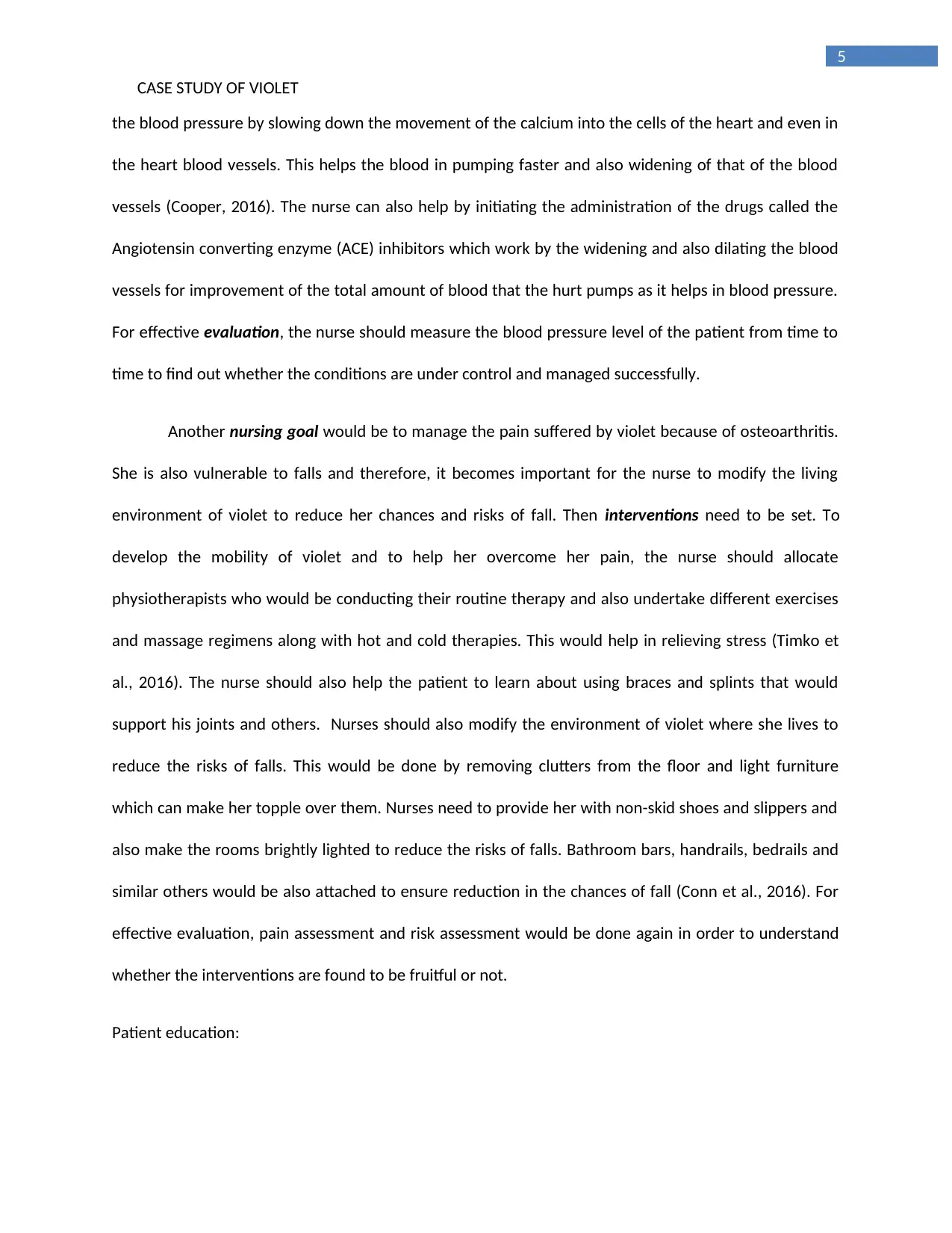
5
CASE STUDY OF VIOLET
the blood pressure by slowing down the movement of the calcium into the cells of the heart and even in
the heart blood vessels. This helps the blood in pumping faster and also widening of that of the blood
vessels (Cooper, 2016). The nurse can also help by initiating the administration of the drugs called the
Angiotensin converting enzyme (ACE) inhibitors which work by the widening and also dilating the blood
vessels for improvement of the total amount of blood that the hurt pumps as it helps in blood pressure.
For effective evaluation, the nurse should measure the blood pressure level of the patient from time to
time to find out whether the conditions are under control and managed successfully.
Another nursing goal would be to manage the pain suffered by violet because of osteoarthritis.
She is also vulnerable to falls and therefore, it becomes important for the nurse to modify the living
environment of violet to reduce her chances and risks of fall. Then interventions need to be set. To
develop the mobility of violet and to help her overcome her pain, the nurse should allocate
physiotherapists who would be conducting their routine therapy and also undertake different exercises
and massage regimens along with hot and cold therapies. This would help in relieving stress (Timko et
al., 2016). The nurse should also help the patient to learn about using braces and splints that would
support his joints and others. Nurses should also modify the environment of violet where she lives to
reduce the risks of falls. This would be done by removing clutters from the floor and light furniture
which can make her topple over them. Nurses need to provide her with non-skid shoes and slippers and
also make the rooms brightly lighted to reduce the risks of falls. Bathroom bars, handrails, bedrails and
similar others would be also attached to ensure reduction in the chances of fall (Conn et al., 2016). For
effective evaluation, pain assessment and risk assessment would be done again in order to understand
whether the interventions are found to be fruitful or not.
Patient education:
CASE STUDY OF VIOLET
the blood pressure by slowing down the movement of the calcium into the cells of the heart and even in
the heart blood vessels. This helps the blood in pumping faster and also widening of that of the blood
vessels (Cooper, 2016). The nurse can also help by initiating the administration of the drugs called the
Angiotensin converting enzyme (ACE) inhibitors which work by the widening and also dilating the blood
vessels for improvement of the total amount of blood that the hurt pumps as it helps in blood pressure.
For effective evaluation, the nurse should measure the blood pressure level of the patient from time to
time to find out whether the conditions are under control and managed successfully.
Another nursing goal would be to manage the pain suffered by violet because of osteoarthritis.
She is also vulnerable to falls and therefore, it becomes important for the nurse to modify the living
environment of violet to reduce her chances and risks of fall. Then interventions need to be set. To
develop the mobility of violet and to help her overcome her pain, the nurse should allocate
physiotherapists who would be conducting their routine therapy and also undertake different exercises
and massage regimens along with hot and cold therapies. This would help in relieving stress (Timko et
al., 2016). The nurse should also help the patient to learn about using braces and splints that would
support his joints and others. Nurses should also modify the environment of violet where she lives to
reduce the risks of falls. This would be done by removing clutters from the floor and light furniture
which can make her topple over them. Nurses need to provide her with non-skid shoes and slippers and
also make the rooms brightly lighted to reduce the risks of falls. Bathroom bars, handrails, bedrails and
similar others would be also attached to ensure reduction in the chances of fall (Conn et al., 2016). For
effective evaluation, pain assessment and risk assessment would be done again in order to understand
whether the interventions are found to be fruitful or not.
Patient education:
⊘ This is a preview!⊘
Do you want full access?
Subscribe today to unlock all pages.

Trusted by 1+ million students worldwide
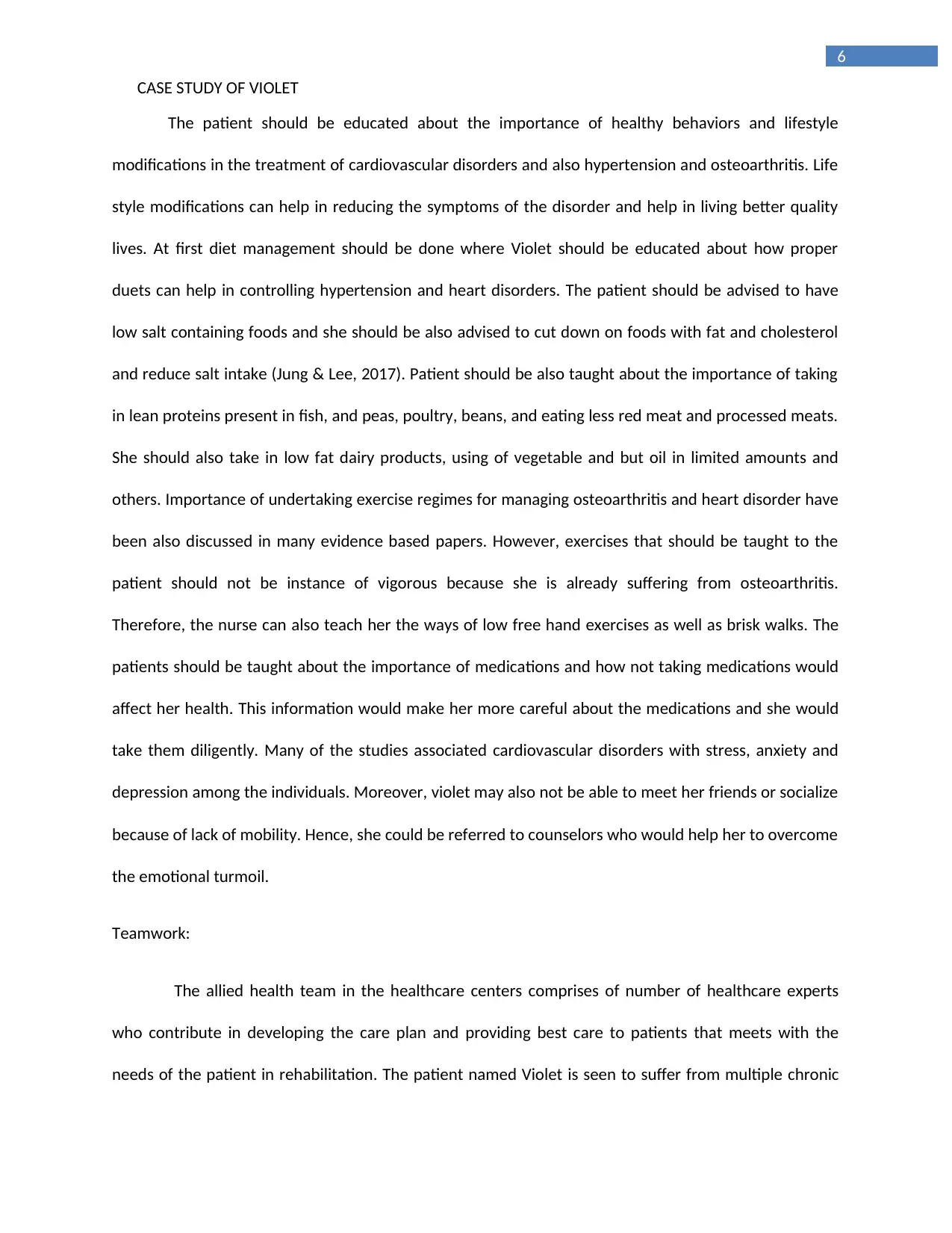
6
CASE STUDY OF VIOLET
The patient should be educated about the importance of healthy behaviors and lifestyle
modifications in the treatment of cardiovascular disorders and also hypertension and osteoarthritis. Life
style modifications can help in reducing the symptoms of the disorder and help in living better quality
lives. At first diet management should be done where Violet should be educated about how proper
duets can help in controlling hypertension and heart disorders. The patient should be advised to have
low salt containing foods and she should be also advised to cut down on foods with fat and cholesterol
and reduce salt intake (Jung & Lee, 2017). Patient should be also taught about the importance of taking
in lean proteins present in fish, and peas, poultry, beans, and eating less red meat and processed meats.
She should also take in low fat dairy products, using of vegetable and but oil in limited amounts and
others. Importance of undertaking exercise regimes for managing osteoarthritis and heart disorder have
been also discussed in many evidence based papers. However, exercises that should be taught to the
patient should not be instance of vigorous because she is already suffering from osteoarthritis.
Therefore, the nurse can also teach her the ways of low free hand exercises as well as brisk walks. The
patients should be taught about the importance of medications and how not taking medications would
affect her health. This information would make her more careful about the medications and she would
take them diligently. Many of the studies associated cardiovascular disorders with stress, anxiety and
depression among the individuals. Moreover, violet may also not be able to meet her friends or socialize
because of lack of mobility. Hence, she could be referred to counselors who would help her to overcome
the emotional turmoil.
Teamwork:
The allied health team in the healthcare centers comprises of number of healthcare experts
who contribute in developing the care plan and providing best care to patients that meets with the
needs of the patient in rehabilitation. The patient named Violet is seen to suffer from multiple chronic
CASE STUDY OF VIOLET
The patient should be educated about the importance of healthy behaviors and lifestyle
modifications in the treatment of cardiovascular disorders and also hypertension and osteoarthritis. Life
style modifications can help in reducing the symptoms of the disorder and help in living better quality
lives. At first diet management should be done where Violet should be educated about how proper
duets can help in controlling hypertension and heart disorders. The patient should be advised to have
low salt containing foods and she should be also advised to cut down on foods with fat and cholesterol
and reduce salt intake (Jung & Lee, 2017). Patient should be also taught about the importance of taking
in lean proteins present in fish, and peas, poultry, beans, and eating less red meat and processed meats.
She should also take in low fat dairy products, using of vegetable and but oil in limited amounts and
others. Importance of undertaking exercise regimes for managing osteoarthritis and heart disorder have
been also discussed in many evidence based papers. However, exercises that should be taught to the
patient should not be instance of vigorous because she is already suffering from osteoarthritis.
Therefore, the nurse can also teach her the ways of low free hand exercises as well as brisk walks. The
patients should be taught about the importance of medications and how not taking medications would
affect her health. This information would make her more careful about the medications and she would
take them diligently. Many of the studies associated cardiovascular disorders with stress, anxiety and
depression among the individuals. Moreover, violet may also not be able to meet her friends or socialize
because of lack of mobility. Hence, she could be referred to counselors who would help her to overcome
the emotional turmoil.
Teamwork:
The allied health team in the healthcare centers comprises of number of healthcare experts
who contribute in developing the care plan and providing best care to patients that meets with the
needs of the patient in rehabilitation. The patient named Violet is seen to suffer from multiple chronic
Paraphrase This Document
Need a fresh take? Get an instant paraphrase of this document with our AI Paraphraser
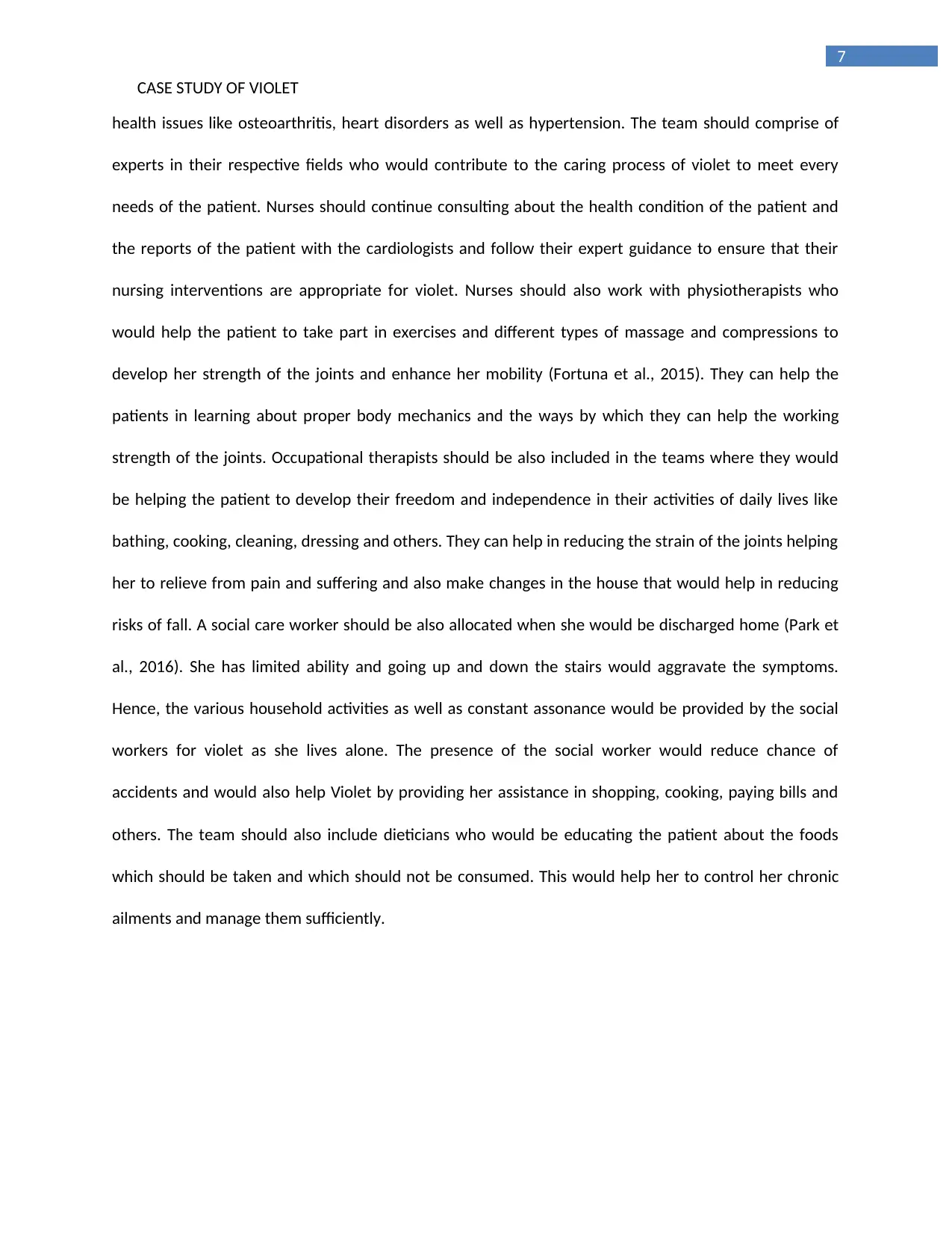
7
CASE STUDY OF VIOLET
health issues like osteoarthritis, heart disorders as well as hypertension. The team should comprise of
experts in their respective fields who would contribute to the caring process of violet to meet every
needs of the patient. Nurses should continue consulting about the health condition of the patient and
the reports of the patient with the cardiologists and follow their expert guidance to ensure that their
nursing interventions are appropriate for violet. Nurses should also work with physiotherapists who
would help the patient to take part in exercises and different types of massage and compressions to
develop her strength of the joints and enhance her mobility (Fortuna et al., 2015). They can help the
patients in learning about proper body mechanics and the ways by which they can help the working
strength of the joints. Occupational therapists should be also included in the teams where they would
be helping the patient to develop their freedom and independence in their activities of daily lives like
bathing, cooking, cleaning, dressing and others. They can help in reducing the strain of the joints helping
her to relieve from pain and suffering and also make changes in the house that would help in reducing
risks of fall. A social care worker should be also allocated when she would be discharged home (Park et
al., 2016). She has limited ability and going up and down the stairs would aggravate the symptoms.
Hence, the various household activities as well as constant assonance would be provided by the social
workers for violet as she lives alone. The presence of the social worker would reduce chance of
accidents and would also help Violet by providing her assistance in shopping, cooking, paying bills and
others. The team should also include dieticians who would be educating the patient about the foods
which should be taken and which should not be consumed. This would help her to control her chronic
ailments and manage them sufficiently.
CASE STUDY OF VIOLET
health issues like osteoarthritis, heart disorders as well as hypertension. The team should comprise of
experts in their respective fields who would contribute to the caring process of violet to meet every
needs of the patient. Nurses should continue consulting about the health condition of the patient and
the reports of the patient with the cardiologists and follow their expert guidance to ensure that their
nursing interventions are appropriate for violet. Nurses should also work with physiotherapists who
would help the patient to take part in exercises and different types of massage and compressions to
develop her strength of the joints and enhance her mobility (Fortuna et al., 2015). They can help the
patients in learning about proper body mechanics and the ways by which they can help the working
strength of the joints. Occupational therapists should be also included in the teams where they would
be helping the patient to develop their freedom and independence in their activities of daily lives like
bathing, cooking, cleaning, dressing and others. They can help in reducing the strain of the joints helping
her to relieve from pain and suffering and also make changes in the house that would help in reducing
risks of fall. A social care worker should be also allocated when she would be discharged home (Park et
al., 2016). She has limited ability and going up and down the stairs would aggravate the symptoms.
Hence, the various household activities as well as constant assonance would be provided by the social
workers for violet as she lives alone. The presence of the social worker would reduce chance of
accidents and would also help Violet by providing her assistance in shopping, cooking, paying bills and
others. The team should also include dieticians who would be educating the patient about the foods
which should be taken and which should not be consumed. This would help her to control her chronic
ailments and manage them sufficiently.
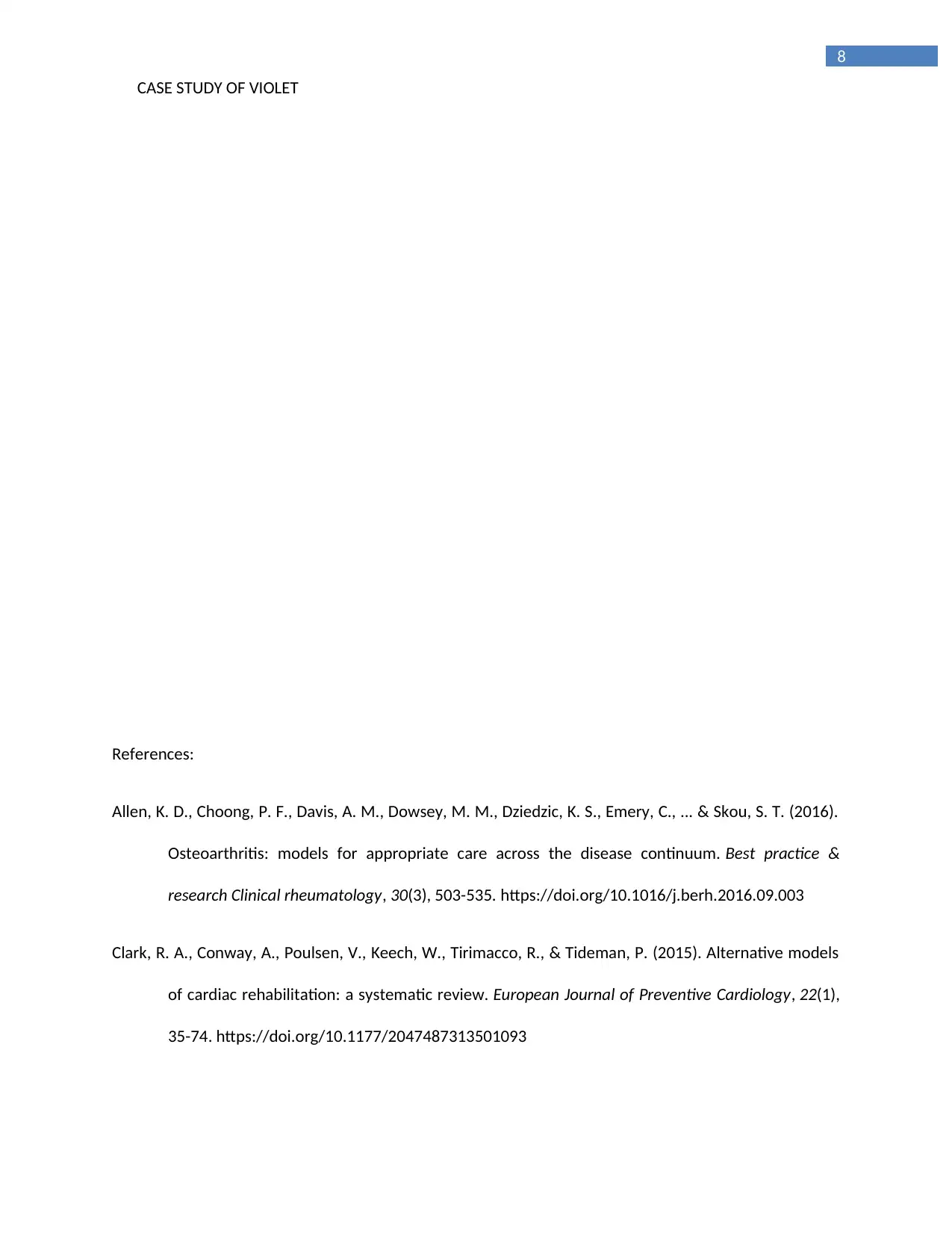
8
CASE STUDY OF VIOLET
References:
Allen, K. D., Choong, P. F., Davis, A. M., Dowsey, M. M., Dziedzic, K. S., Emery, C., ... & Skou, S. T. (2016).
Osteoarthritis: models for appropriate care across the disease continuum. Best practice &
research Clinical rheumatology, 30(3), 503-535. https://doi.org/10.1016/j.berh.2016.09.003
Clark, R. A., Conway, A., Poulsen, V., Keech, W., Tirimacco, R., & Tideman, P. (2015). Alternative models
of cardiac rehabilitation: a systematic review. European Journal of Preventive Cardiology, 22(1),
35-74. https://doi.org/10.1177/2047487313501093
CASE STUDY OF VIOLET
References:
Allen, K. D., Choong, P. F., Davis, A. M., Dowsey, M. M., Dziedzic, K. S., Emery, C., ... & Skou, S. T. (2016).
Osteoarthritis: models for appropriate care across the disease continuum. Best practice &
research Clinical rheumatology, 30(3), 503-535. https://doi.org/10.1016/j.berh.2016.09.003
Clark, R. A., Conway, A., Poulsen, V., Keech, W., Tirimacco, R., & Tideman, P. (2015). Alternative models
of cardiac rehabilitation: a systematic review. European Journal of Preventive Cardiology, 22(1),
35-74. https://doi.org/10.1177/2047487313501093
⊘ This is a preview!⊘
Do you want full access?
Subscribe today to unlock all pages.

Trusted by 1+ million students worldwide
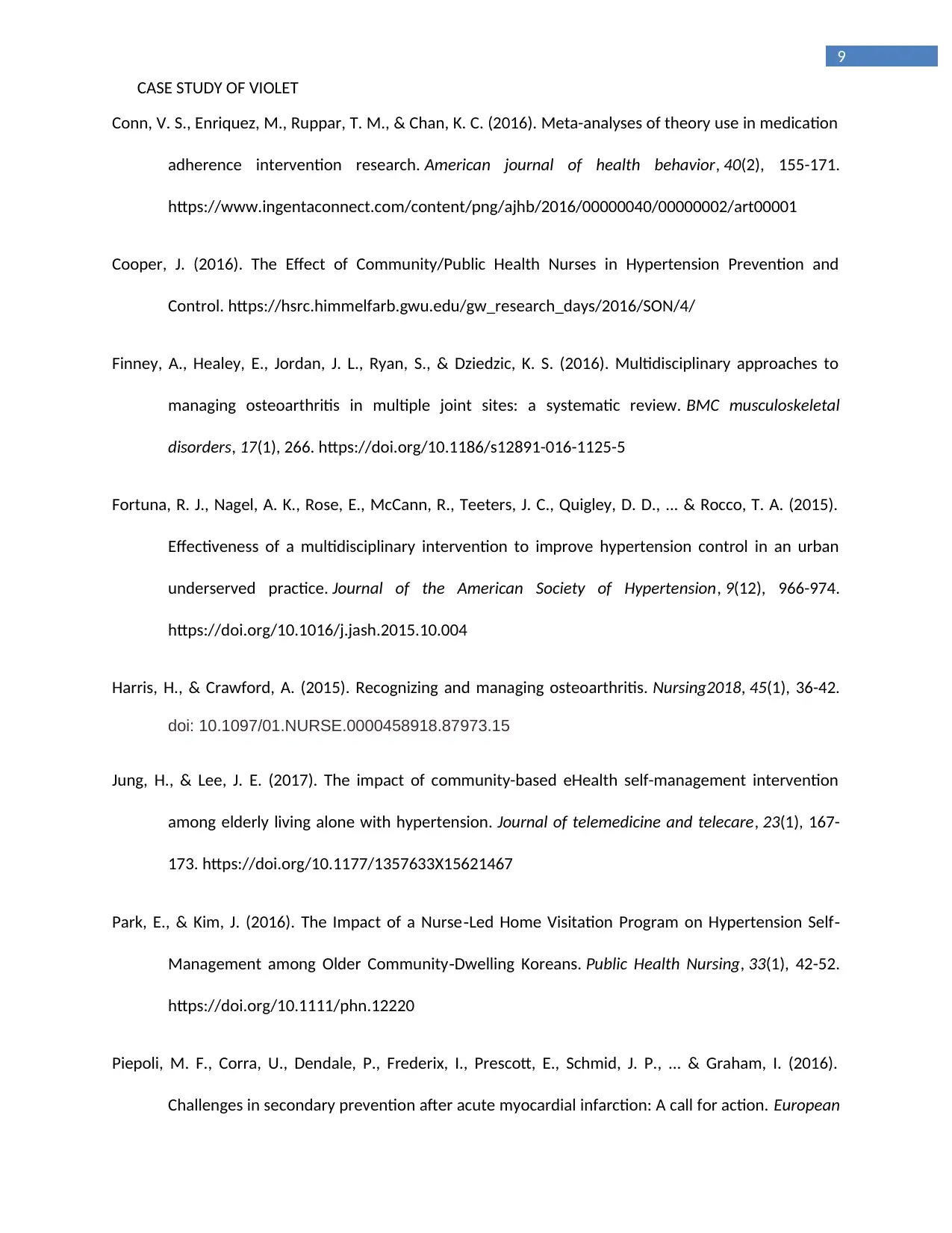
9
CASE STUDY OF VIOLET
Conn, V. S., Enriquez, M., Ruppar, T. M., & Chan, K. C. (2016). Meta-analyses of theory use in medication
adherence intervention research. American journal of health behavior, 40(2), 155-171.
https://www.ingentaconnect.com/content/png/ajhb/2016/00000040/00000002/art00001
Cooper, J. (2016). The Effect of Community/Public Health Nurses in Hypertension Prevention and
Control. https://hsrc.himmelfarb.gwu.edu/gw_research_days/2016/SON/4/
Finney, A., Healey, E., Jordan, J. L., Ryan, S., & Dziedzic, K. S. (2016). Multidisciplinary approaches to
managing osteoarthritis in multiple joint sites: a systematic review. BMC musculoskeletal
disorders, 17(1), 266. https://doi.org/10.1186/s12891-016-1125-5
Fortuna, R. J., Nagel, A. K., Rose, E., McCann, R., Teeters, J. C., Quigley, D. D., ... & Rocco, T. A. (2015).
Effectiveness of a multidisciplinary intervention to improve hypertension control in an urban
underserved practice. Journal of the American Society of Hypertension, 9(12), 966-974.
https://doi.org/10.1016/j.jash.2015.10.004
Harris, H., & Crawford, A. (2015). Recognizing and managing osteoarthritis. Nursing2018, 45(1), 36-42.
doi: 10.1097/01.NURSE.0000458918.87973.15
Jung, H., & Lee, J. E. (2017). The impact of community-based eHealth self-management intervention
among elderly living alone with hypertension. Journal of telemedicine and telecare, 23(1), 167-
173. https://doi.org/10.1177/1357633X15621467
Park, E., & Kim, J. (2016). The Impact of a Nurse‐Led Home Visitation Program on Hypertension Self‐
Management among Older Community‐Dwelling Koreans. Public Health Nursing, 33(1), 42-52.
https://doi.org/10.1111/phn.12220
Piepoli, M. F., Corra, U., Dendale, P., Frederix, I., Prescott, E., Schmid, J. P., ... & Graham, I. (2016).
Challenges in secondary prevention after acute myocardial infarction: A call for action. European
CASE STUDY OF VIOLET
Conn, V. S., Enriquez, M., Ruppar, T. M., & Chan, K. C. (2016). Meta-analyses of theory use in medication
adherence intervention research. American journal of health behavior, 40(2), 155-171.
https://www.ingentaconnect.com/content/png/ajhb/2016/00000040/00000002/art00001
Cooper, J. (2016). The Effect of Community/Public Health Nurses in Hypertension Prevention and
Control. https://hsrc.himmelfarb.gwu.edu/gw_research_days/2016/SON/4/
Finney, A., Healey, E., Jordan, J. L., Ryan, S., & Dziedzic, K. S. (2016). Multidisciplinary approaches to
managing osteoarthritis in multiple joint sites: a systematic review. BMC musculoskeletal
disorders, 17(1), 266. https://doi.org/10.1186/s12891-016-1125-5
Fortuna, R. J., Nagel, A. K., Rose, E., McCann, R., Teeters, J. C., Quigley, D. D., ... & Rocco, T. A. (2015).
Effectiveness of a multidisciplinary intervention to improve hypertension control in an urban
underserved practice. Journal of the American Society of Hypertension, 9(12), 966-974.
https://doi.org/10.1016/j.jash.2015.10.004
Harris, H., & Crawford, A. (2015). Recognizing and managing osteoarthritis. Nursing2018, 45(1), 36-42.
doi: 10.1097/01.NURSE.0000458918.87973.15
Jung, H., & Lee, J. E. (2017). The impact of community-based eHealth self-management intervention
among elderly living alone with hypertension. Journal of telemedicine and telecare, 23(1), 167-
173. https://doi.org/10.1177/1357633X15621467
Park, E., & Kim, J. (2016). The Impact of a Nurse‐Led Home Visitation Program on Hypertension Self‐
Management among Older Community‐Dwelling Koreans. Public Health Nursing, 33(1), 42-52.
https://doi.org/10.1111/phn.12220
Piepoli, M. F., Corra, U., Dendale, P., Frederix, I., Prescott, E., Schmid, J. P., ... & Graham, I. (2016).
Challenges in secondary prevention after acute myocardial infarction: A call for action. European
Paraphrase This Document
Need a fresh take? Get an instant paraphrase of this document with our AI Paraphraser
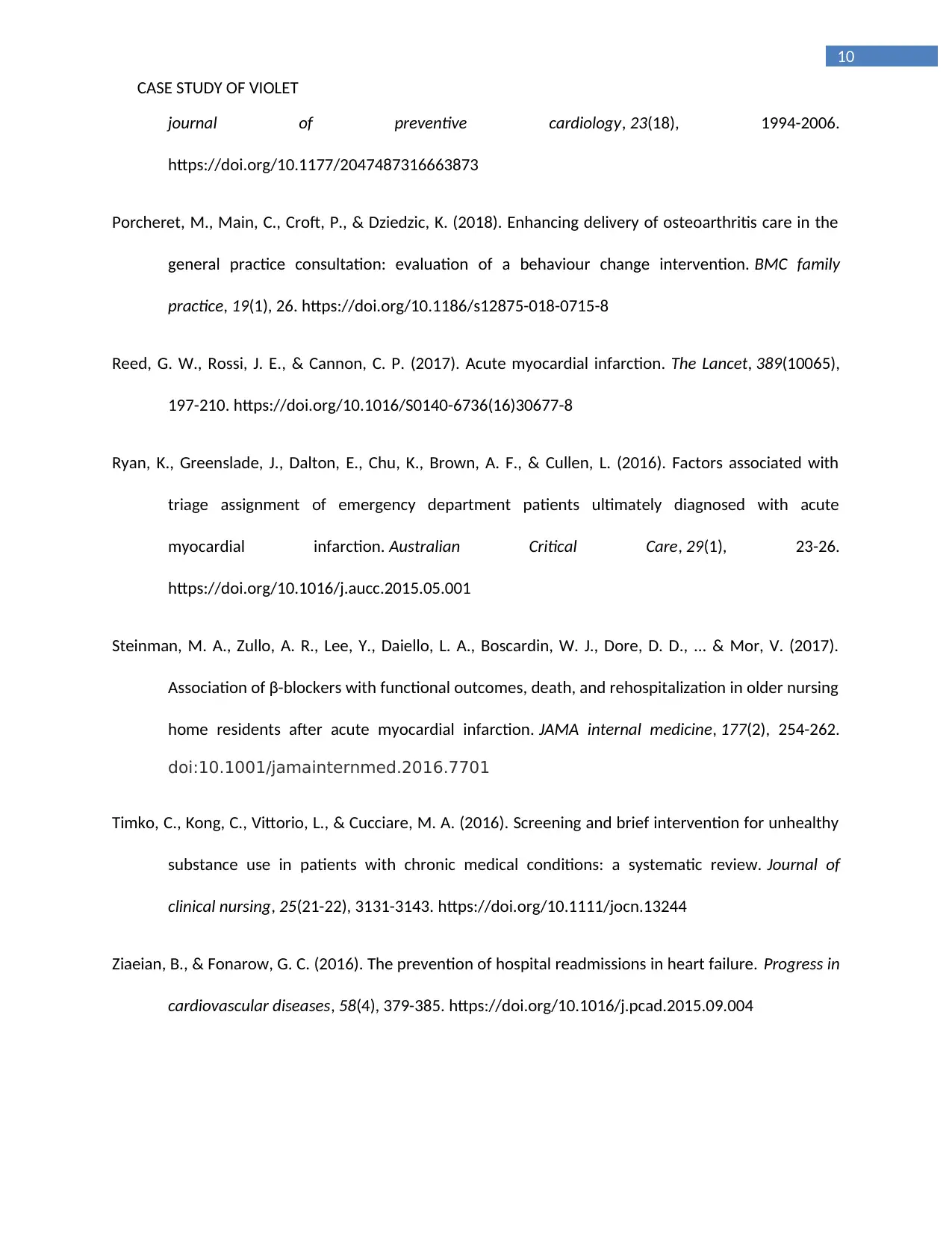
10
CASE STUDY OF VIOLET
journal of preventive cardiology, 23(18), 1994-2006.
https://doi.org/10.1177/2047487316663873
Porcheret, M., Main, C., Croft, P., & Dziedzic, K. (2018). Enhancing delivery of osteoarthritis care in the
general practice consultation: evaluation of a behaviour change intervention. BMC family
practice, 19(1), 26. https://doi.org/10.1186/s12875-018-0715-8
Reed, G. W., Rossi, J. E., & Cannon, C. P. (2017). Acute myocardial infarction. The Lancet, 389(10065),
197-210. https://doi.org/10.1016/S0140-6736(16)30677-8
Ryan, K., Greenslade, J., Dalton, E., Chu, K., Brown, A. F., & Cullen, L. (2016). Factors associated with
triage assignment of emergency department patients ultimately diagnosed with acute
myocardial infarction. Australian Critical Care, 29(1), 23-26.
https://doi.org/10.1016/j.aucc.2015.05.001
Steinman, M. A., Zullo, A. R., Lee, Y., Daiello, L. A., Boscardin, W. J., Dore, D. D., ... & Mor, V. (2017).
Association of β-blockers with functional outcomes, death, and rehospitalization in older nursing
home residents after acute myocardial infarction. JAMA internal medicine, 177(2), 254-262.
doi:10.1001/jamainternmed.2016.7701
Timko, C., Kong, C., Vittorio, L., & Cucciare, M. A. (2016). Screening and brief intervention for unhealthy
substance use in patients with chronic medical conditions: a systematic review. Journal of
clinical nursing, 25(21-22), 3131-3143. https://doi.org/10.1111/jocn.13244
Ziaeian, B., & Fonarow, G. C. (2016). The prevention of hospital readmissions in heart failure. Progress in
cardiovascular diseases, 58(4), 379-385. https://doi.org/10.1016/j.pcad.2015.09.004
CASE STUDY OF VIOLET
journal of preventive cardiology, 23(18), 1994-2006.
https://doi.org/10.1177/2047487316663873
Porcheret, M., Main, C., Croft, P., & Dziedzic, K. (2018). Enhancing delivery of osteoarthritis care in the
general practice consultation: evaluation of a behaviour change intervention. BMC family
practice, 19(1), 26. https://doi.org/10.1186/s12875-018-0715-8
Reed, G. W., Rossi, J. E., & Cannon, C. P. (2017). Acute myocardial infarction. The Lancet, 389(10065),
197-210. https://doi.org/10.1016/S0140-6736(16)30677-8
Ryan, K., Greenslade, J., Dalton, E., Chu, K., Brown, A. F., & Cullen, L. (2016). Factors associated with
triage assignment of emergency department patients ultimately diagnosed with acute
myocardial infarction. Australian Critical Care, 29(1), 23-26.
https://doi.org/10.1016/j.aucc.2015.05.001
Steinman, M. A., Zullo, A. R., Lee, Y., Daiello, L. A., Boscardin, W. J., Dore, D. D., ... & Mor, V. (2017).
Association of β-blockers with functional outcomes, death, and rehospitalization in older nursing
home residents after acute myocardial infarction. JAMA internal medicine, 177(2), 254-262.
doi:10.1001/jamainternmed.2016.7701
Timko, C., Kong, C., Vittorio, L., & Cucciare, M. A. (2016). Screening and brief intervention for unhealthy
substance use in patients with chronic medical conditions: a systematic review. Journal of
clinical nursing, 25(21-22), 3131-3143. https://doi.org/10.1111/jocn.13244
Ziaeian, B., & Fonarow, G. C. (2016). The prevention of hospital readmissions in heart failure. Progress in
cardiovascular diseases, 58(4), 379-385. https://doi.org/10.1016/j.pcad.2015.09.004

11
CASE STUDY OF VIOLET
CASE STUDY OF VIOLET
⊘ This is a preview!⊘
Do you want full access?
Subscribe today to unlock all pages.

Trusted by 1+ million students worldwide
1 out of 12
Related Documents
Your All-in-One AI-Powered Toolkit for Academic Success.
+13062052269
info@desklib.com
Available 24*7 on WhatsApp / Email
![[object Object]](/_next/static/media/star-bottom.7253800d.svg)
Unlock your academic potential
Copyright © 2020–2025 A2Z Services. All Rights Reserved. Developed and managed by ZUCOL.





